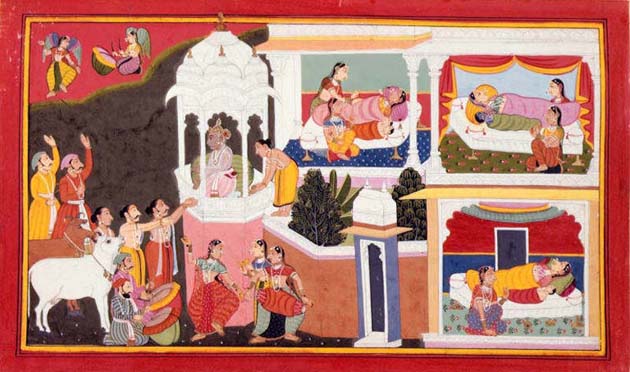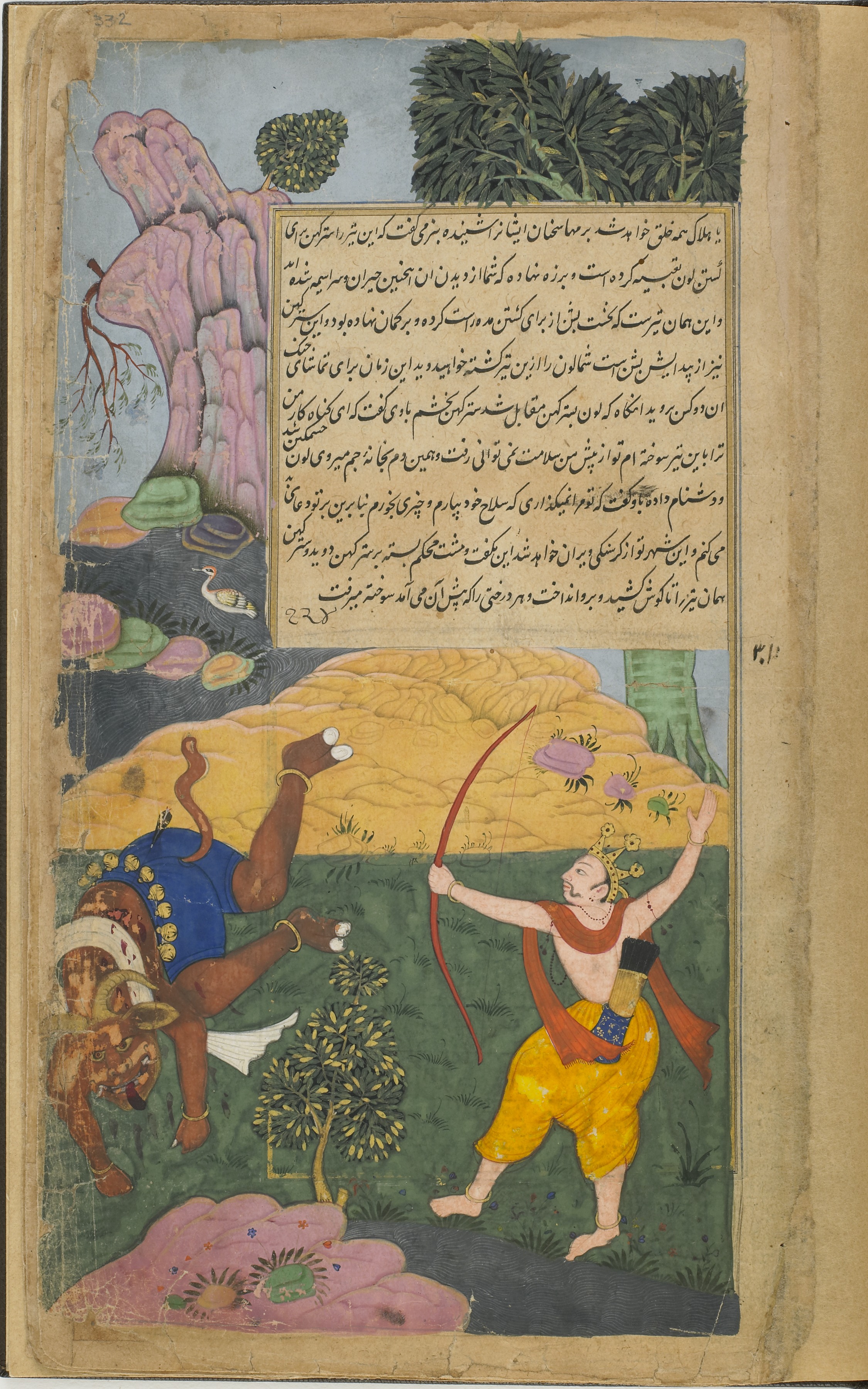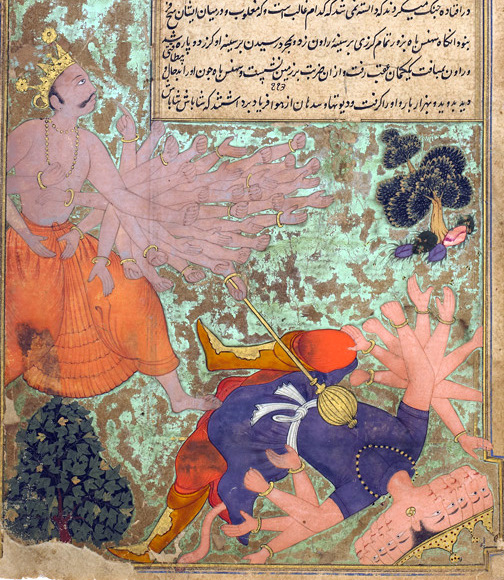|
Sumitra
Sumitra ( sa, सुमित्रा, IAST: Sumitrā) is a princess of Kashi in Hindu mythology. The wise Sumitra is the third queen consort of Dasharatha, the king of Kosala, who ruled from Ayodhya. She is the mother of the twins Lakshmana and Shatrughna as mentioned in the Hindu epic, the Ramayana. Etymology The name Sumitra is of Sanskrit origin, and could be divided into ''Su'' meaning good, and ''Mitra,'' meaning friend''.'' Thus'','' her name means 'a good friend' or 'one with a friendly nature'. She is known in other languages as Tamil: சுமித்திரை, Burmese: Thumitra, Malay: Samutra, Khmer '' and '' th, สมุทรเทวี ''Samutthra Thewi''). Legend At the sacrifice conducted by Rishyasringa to obtain sons for the childless Dasharatha, a divine being emerged from the flames with a golden vessel filled with divine ''payasam''. Dasharatha offered half to Kausalya, a quarter (literally half of that which remained) to Sumitra, an eighth ... [...More Info...] [...Related Items...] OR: [Wikipedia] [Google] [Baidu] |
Ramayana
The ''Rāmāyana'' (; sa, रामायणम्, ) is a Sanskrit literature, Sanskrit Indian epic poetry, epic composed over a period of nearly a millennium, with scholars' estimates for the earliest stage of the text ranging from the 8th to 4th centuries BCE, and later stages extending up to the 3rd century CE. ''Ramayana'' is one of the two important epics of Hinduism, the other being the ''Mahabharata, Mahābhārata''. The epic, traditionally ascribed to the Maharishi Valmiki, narrates the life of Sita, the Princess of Janakpur, and Rama, a legendary prince of Ayodhya city in the kingdom of Kosala. The epic follows his fourteen-year exile to the forest urged by his father King Dasharatha, on the request of Rama's stepmother Kaikeyi; his travels across forests in the South Asia, Indian subcontinent with his wife Sita and brother Lakshmana, the kidnapping of Sita by Ravana – the king of Lanka, that resulted in war; and Rama's eventual return to Ayodhya to be crowned kin ... [...More Info...] [...Related Items...] OR: [Wikipedia] [Google] [Baidu] |
Dasharatha
Dasharatha (Sanskrit: दशरथ, IAST: Daśaratha; born Nemi) was the king of the Kosala kingdom and a scion of the Suryavamsha dynasty in Hinduism. He ruled from this capital at Ayodhya. Dasharatha was the son of Aja and Indumati. He had three primary consorts: Kausalya, Kaikeyi, and Sumitra, and from these unions were born Shanta, Rama, Bharata, Lakshmana, and Shatrughna. He is mentioned in the scriptures of Ramayana and Vishnu Purana. Legend Early life King Dasharatha was believed to be an incarnation of Svayambhuva Manu, the son of the Hindu creator god, Brahma. Dasharatha was the son of King Aja of Kosala and Indumati of Vidarbha. He was originally named Nemi, but he acquired the moniker ''Dasharatha'' (Ten chariots) as his chariot could move in all ten directions, fly, as well as return to earth, and he could fight with ease in all of these directions. Dasharatha became the ruler of Kosala after the death of his father. He was a great warrior who subjugated ... [...More Info...] [...Related Items...] OR: [Wikipedia] [Google] [Baidu] |
Dasharatha Give Payasa To His Wives
Dasharatha (Sanskrit: दशरथ, IAST: Daśaratha; born Nemi) was the king of the Kosala kingdom and a scion of the Suryavamsha dynasty in Hinduism. He ruled from this capital at Ayodhya. Dasharatha was the son of Aja and Indumati. He had three primary consorts: Kausalya, Kaikeyi, and Sumitra, and from these unions were born Shanta, Rama, Bharata, Lakshmana, and Shatrughna. He is mentioned in the scriptures of Ramayana and Vishnu Purana. Legend Early life King Dasharatha was believed to be an incarnation of Svayambhuva Manu, the son of the Hindu creator god, Brahma. Dasharatha was the son of King Aja of Kosala and Indumati of Vidarbha. He was originally named Nemi, but he acquired the moniker ''Dasharatha'' (Ten chariots) as his chariot could move in all ten directions, fly, as well as return to earth, and he could fight with ease in all of these directions. Dasharatha became the ruler of Kosala after the death of his father. He was a great warrior who subjugated ma ... [...More Info...] [...Related Items...] OR: [Wikipedia] [Google] [Baidu] |
Solar Dynasty
The Solar dynasty (IAST: Suryavaṃśa or Ravivaṃśa in Sanskrit) or the Ikshvaku dynasty was founded by the legendary king Ikshvaku.Geography of Rigvedic India, M.L. Bhargava, Lucknow 1964, pp. 15-18, 46-49, 92-98, 100-/1, 136 The dynasty is also known as ("Solar dynasty" or "Descendants of the Sun") which means that this dynasty prays to the Sun as their God and their originator (the Gayatri Mantra is a prayer offered to the Sun God as the Sun is the main deity of the Solar Dynasty), and along with Lunar dynasty comprises one of the main lineages of the Kshatriya Varna. The first ''Tirthankara'' of Jainism, Rishabhdeva himself was King Ikshvaku. Further, 21 Tirthankaras of Jainism were born in this dynasty. According to Buddhist texts and tradition, Gautama Buddha descended from this dynasty. Many later kings of the Indian subcontinent claimed to be of Suryavamsha descent. The important personalities belonging to this royal house are Mandhatri, Muchukunda, Ambarisha, B ... [...More Info...] [...Related Items...] OR: [Wikipedia] [Google] [Baidu] |
Lakshmana
Lakshmana ( sa, लक्ष्मण, lit=the fortunate one, translit=Lakṣmaṇa), also spelled as Laxmana, is the younger brother of Rama and his loyalist in the Hindu epic ''Ramayana''. He bears the epithets of Saumitra () and Ramanuja (). He is the twin of Shatrughna. Legend Birth and marriage King Dasharatha of Ayodhya had three wives: Kausalya, Kaikeyi, and Sumitra. He performed a sacrifice to beget sons and as a result, his queens became pregnant. Lakshmana and his brother Shatrughna were born to Sumitra, while Rama and Bharata were born to Kausalya and Kaikeyi. In the Puranas, Lakshmana is described as an incarnation of Shesha, the multiple-headed naga (serpent) upon whom rests the preserver deity Vishnu, whose avatar Rama is considered to be. When sage Vishvamitra asked Rama to kill the demons in the forest, Lakshmana accompanied them and went to Mithila with them. Lakshmana was especially attached to Rama. When Rama married Sita, Lakshmana married Sita's ... [...More Info...] [...Related Items...] OR: [Wikipedia] [Google] [Baidu] |
Kausalya
Kausalya () is the senior queen-consort of Kosala in the Hindu epic ''Ramayana''. She is the mother of Rama, the titular hero of the epic, and the senior wife of Dasharatha, who ruled Kosala from its capital of Ayodhya. In some later accounts, Shanta is described as her daughter, and the eldest child, of Dasharatha. However, in the ''Bala Kanda'' of the ''Ramayana'', Valmiki writes of Shanta only as the daughter of Romapada, the king of Anga, who was a friend of Dasharatha. At no point is Shanta's mother named. Legend Valmiki does not mention the names of Kausalya's parents, but in the 'Ayodhya Kanda' she is described as ''Kosalendraduhitā'' (daughter of the king of Kosala). Later texts name her as the daughter of the King Sukaushala and Queen Amritaprabha of Dakshina Kosala. At her traditionally ascribed birthplace, there exists a temple dedicated to her called the Mata Kaushalya Temple, which is perhaps among the few temples dedicated to her. At the sacrifice per ... [...More Info...] [...Related Items...] OR: [Wikipedia] [Google] [Baidu] |
Shatrughna
''Shatrughna'' ( sa, text=शत्रुघ्न, translit=śatrughna, lit=killer of enemies) is a prince of Ayodhya, King of Madhupura and Vidisha, and a brother of Prince Rama in the Hindu epic ''Ramayana''. He is also known as ''Ripudaman'' (vanquisher of foes). He is the twin of Lakshmana. He is a loyalist of Bharata, just like Lakshmana is to Rama. According to the Valmiki Ramayana, Shatrughna is one aspect of the manifestation of Vishnu (Rama). Shatrughna also appears as the 412th name of Vishnu in the Vishnu Sahasranama of the Mahabharata. According to the ''Ramayana'', Rama is the seventh avatar of Vishnu, while Lakshmana, Shatrughna, and Bharata are the avatars of Sheshanaga, Panchajanya, and the Sudarshana Chakra respectively. Birth and family Shatrughna was born to the king of Ayodhya, Dasharatha, and his third wife, Queen Sumitra, a princess of Kashi. Dasharatha's other two wives, Kaushalya and Kaikeyi, bore children who would be his half-brothers. Kaushaly ... [...More Info...] [...Related Items...] OR: [Wikipedia] [Google] [Baidu] |
Heheya Kingdom
The Heheya Kingdom (also known as Haihaya, Haiheya, Heiheya _sa.html" ;"title="nowiki/> sa">हैहय was a kingdom ruled by the Yadava people, who claimed to be descended from Yadu, a legendary king of Chandravamsha lineage. One of the most well known Haihaya rulers was Kartavirya Arjuna. It is believed that the Kingdom was involved with a number of conflicts with neighboring kingdoms, and it is believed that it was ultimately defeated by the Bhargava leader Parashurama. The capital of the Heheya Kingdom was Mahishmati, located on the banks of the Narmada River in present-day Madhya Pradesh. Haihaya clans The Haihayas were an ancient confederacy of five ''gana''s (clans), who claimed their common ancestry from Yadu. According to the ''Harivamsha Purana'' (34.1898), Haihaya was the great-grandson of Yadu and grandson of Sahasrajit.Pargiter, F.E. (1972) 922 ''Ancient Indian Historical Tradition'', Delhi: Motilal Banarsidass, p.87. In the ''Vishnu Purana'' (IV.11), al ... [...More Info...] [...Related Items...] OR: [Wikipedia] [Google] [Baidu] |
Kosala
The Kingdom of Kosala (Sanskrit: ) was an ancient Indian kingdom with a rich culture, corresponding to the area within the region of Awadh in present-day Uttar Pradesh to Western Odisha. It emerged as a janapada, small state during the late Vedic period, with connections to the neighbouring realm of Videha. Kosala belonged to the Northern Black Polished Ware culture (c. 700–300 BCE), and the Kosala region gave rise to the Sramana movements, including Jainism and Buddhism. It was culturally distinct from the Painted Grey Ware culture of the Vedic period of Kuru Kingdom, Kuru-Pañcāla, Panchala west of it, following independent development toward Second Urbanisation, urbanisation and the use of iron. During the 5th century BCE, Kosala incorporated the territory of the Shakya clan, to which the Buddha belonged. According to the Buddhist text ''Aṅguttara Nikāya'' and the Jaina text, the ''Vyākhyāprajñapti, Bhagavati Sutra'', Kosala was one of the ''Solasa'' (sixteen) Mahaj ... [...More Info...] [...Related Items...] OR: [Wikipedia] [Google] [Baidu] |
Sanskrit
Sanskrit (; attributively , ; nominally , , ) is a classical language belonging to the Indo-Aryan branch of the Indo-European languages. It arose in South Asia after its predecessor languages had diffused there from the northwest in the late Bronze Age. Sanskrit is the sacred language of Hinduism, the language of classical Hindu philosophy, and of historical texts of Buddhism and Jainism. It was a link language in ancient and medieval South Asia, and upon transmission of Hindu and Buddhist culture to Southeast Asia, East Asia and Central Asia in the early medieval era, it became a language of religion and high culture, and of the political elites in some of these regions. As a result, Sanskrit had a lasting impact on the languages of South Asia, Southeast Asia and East Asia, especially in their formal and learned vocabularies. Sanskrit generally connotes several Old Indo-Aryan language varieties. The most archaic of these is the Vedic Sanskrit found in the Rig Veda, a colle ... [...More Info...] [...Related Items...] OR: [Wikipedia] [Google] [Baidu] |
Rama
Rama (; ), Ram, Raman or Ramar, also known as Ramachandra (; , ), is a major deity in Hinduism. He is the seventh and one of the most popular '' avatars'' of Vishnu. In Rama-centric traditions of Hinduism, he is considered the Supreme Being. Rama is said to have been born to Kaushalya and Dasharatha in Ayodhya, the ruler of the Kingdom of Kosala. His siblings included Lakshmana, Bharata, and Shatrughna. He married Sita. Though born in a royal family, their life is described in the Hindu texts as one challenged by unexpected changes such as an exile into impoverished and difficult circumstances, ethical questions and moral dilemmas. Of all their travails, the most notable is the kidnapping of Sita by demon-king Ravana, followed by the determined and epic efforts of Rama and Lakshmana to gain her freedom and destroy the evil Ravana against great odds. The entire life story of Rama, Sita and their companions allegorically discusses duties, rights and social responsibil ... [...More Info...] [...Related Items...] OR: [Wikipedia] [Google] [Baidu] |
Kingdom Of Kashi
Kingdom commonly refers to: * A monarchy ruled by a king or queen * Kingdom (biology), a category in biological taxonomy Kingdom may also refer to: Arts and media Television * ''Kingdom'' (British TV series), a 2007 British television drama starring Stephen Fry * ''Kingdom'' (American TV series), a 2014 US television drama starring Frank Grillo * ''Kingdom'' (South Korean TV series), a 2019 South Korean television series *'' Kingdom: Legendary War'', a 2021 South Korean television series Music * Kingdom (group), a South Korean boy group * ''Kingdom'' (Koda Kumi album), 2008 * ''Kingdom'' (Bilal Hassani album), 2019 * ''Kingdom'' (Covenant Worship album), 2014 * ''Kingdoms'' (Life in Your Way album), 2011 * ''Kingdoms'' (Broadway album), 2009 * ''Kingdom'' (EP), a 1998 EP by Vader * "Kingdom" (Dave Gahan song), 2007 * "Kingdom" (Maverick City Music and Kirk Franklin song), 2022 * "Kingdom", a song by Battle Beast on their 2013 album '' Battle Beast'' * "Kingdom", a so ... [...More Info...] [...Related Items...] OR: [Wikipedia] [Google] [Baidu] |











